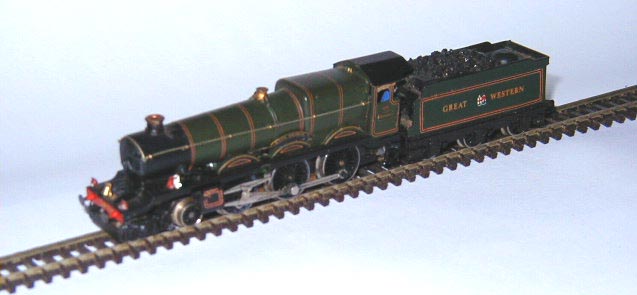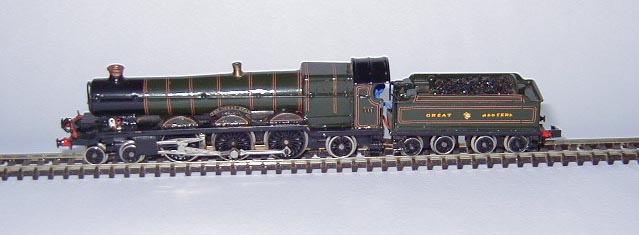
Scouring through model railway magazines and attending local exhibitions, I began to acquire a few loco kits to fit Grafar chassis and also resorted to kit bashing to make other classes of locos. For example a Grafar 'Castle' could be converted to a 'Star' and the 'Hall' to a 'Saint', albeit not accurate but very passable in such a small scale. Above all I wanted a King and 'The Great Bear'. As no kit or proprietary model was available with the correct size boiler and fire box to modify, I tried my hand at scratch building starting with 'The Great Bear'.


This white elephant, Britain's first Pacific designed by Churchward in 1908 was the largest locomotive to run on British Metals until 20 years later when Gresley produced his first Pacific. It was essentially a 'Star' with a greatly increased boiler and could only run on the Paddington to Bristol main line due to its weight. The fact that the motion was a 'Star' I could build it on a Grafar Castle chassis. Constructed of brass tube and strip and the odd bit of plasticard it was not as difficult as I first thought. Regretfully I did not photograph any stages of its construction but made amends for that when I started on 6000 'King George V'. The most taxing thing here was the design of the bogey. The prototype bogey had had outside frames on the leading wheels and inside frames on the trailing wheels to clear the outside cylinders. For the model to look like a 'King' it had to be the same, similar to 'The Great Bear' the running plate had to fit on a Grafar 'Castle' chassis. It also had to have the bell on the buffer beam commemorating its trip to America in 1927 with William Stannier at the Centenary of the Baltimore and Ohio Railroad.

Locomotive Stock |
|||
|---|---|---|---|
| Graham Farish | 4-6-0 | Winchester Castle 5042 | Re-numbered 5069 Isambard Kingdom Brunel |
| Graham Farish | 4-6-0 | Winchester Castle 5042 | Modified to 4000 North Star |
| Graham Farish | 4-6-0 | Raveningham Hall 6960 | Renumbered 4996 Eden Hall |
| Graham Farish | 4-6-0 | Raveningham Hall 6960 | Modified to 2924 Saint Helena |
| Graham Farish | 4-6-0 | Castle Chassis | Scratch built 111 The Great Bear 4-6-2 |
| Graham Farish | 4-6-0 | Castle Chassis | Scratch built 6000 King George V 4-6-0 |
| Graham Farish | 4-6-2 | 6104 | |
| Graham Farish | 0-6-0 | 5788 Chassis | White Metal Kit 0-6-0 2251 |
| Graham Farish | 4-4-0 | 4P Chassis | White Metal Kit 4-4-2 County Tank 2235 |
| Graham Farish | 2-8-0 | 8F Chassis | Modified - Gem White Metal Kit 2800 Class No. 2840 2-8-0 |
| Graham Farish | 0-6-2 | 5788 Chassis | Modified - White Metal Kit 5600 Class No. 5607 0-6-2 |
| Graham Farish | 0-6-0 | 5788 | |
| 2-6-0 | 2600 | Scratch Built Outside Crank Aberdare No. 2632 | |
| Langley Miniature Models | 1400 Class No. 1437 | White Metal & Etched Brass Auto Trailer Car powered by Graham Farish HST chassis in trailer car. | |
| Langley Miniature Models | Steam Rail Motor | Much modified power chassis of unknown make. |
|
